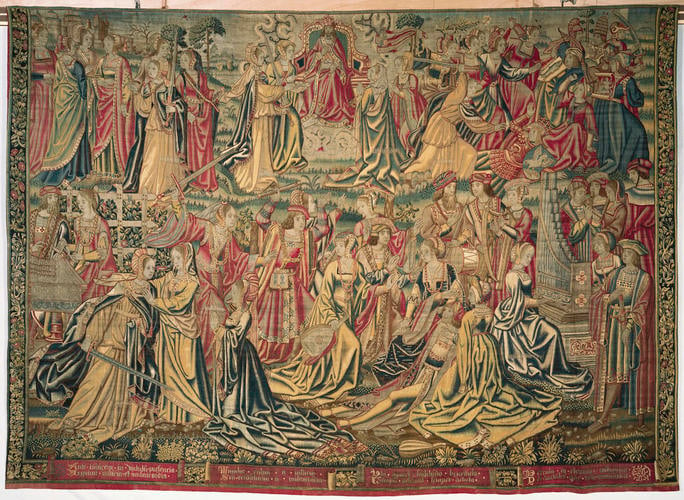The Redemption of Man early 16th century
Woven silk and wool tapestry | 403.0 x 762.0 cm (whole object) | RCIN 1271

Flemish
The Redemption of Man early 16th century

Flemish
Master: The Redemption of Man Item: Dancing early 16th century

Flemish
Master: The Redemption of Man Item: Music early 16th century



-
Three panels from a series of Flemish tapestries depicting the conflict of Virtues and Vices. The scenes depicted are: Dancing; Music; and The Redemption of Man.
In The Redemption of Man (RCIN 1271.1), Justitia, Misericordia, Veritas and Pax are seen pleading for or against Man before the Trinity. Caritas and Humilitas, crowned as queens, are seated beside one of the Trinity representing the Saviour, whilst before them Misericordia, Natura and Miseria are holding out a charter. Justitia holds a long sword. In the top left corner a man and a woman embrace, while next to them in a Gothic pavilion a richly robed group of Virtues discuss their sin, holding out a handkerchief on which the latter is depicted. To the right of the central Trinity is a group in which Man is waiting in the background and Temptator is blowing a curved horn to urge on the attack. In the lower portion, on the left Homo accompanied by Luxuria is assailed by Justitia with her sword. Justitia is held and restrained by Misericordia. On the right Homo is seen with Misericordia; Gratia Dei offers him a breastplate and Pax a helmet. The figures in the two lower corners are Prophets, a pair of whom occur in all the panels except the Creation. On the left is Jeremish holding out a scroll on which is the abbreviated text "Ascendit mors per fenestras" (Death is come up into our windows. Jer. 9,12) and on the right Moses with the text "Reddam ulcionem hostibus" (I will render vengeance to mine enemies. Deut. 32,41).
RCIN 1271.2, known as "Music" since the early twentieth century, depicts Justice disarmed by Mercy. Justice attacks Man who falls back in alarm. Mercy (Misericordia) gently restrains her and Peace kneels in supplication on Man's behalf. On the right is a lady seated at an organ surrounded by a group of musicians, some of whom are flying from the threat of a pursuing Justice armed with a sword. In the upper portion Christ is seated on a throne and Justice is attacking the armed Vices with emblems on their shields. Narrow borders with flowers and foliage. On a red strip are Latin couplets which read "Before the Judge, in the Presence of the Virtues, Justice and Pity plead their cause. Sin (Man) is threatened by Justice but reconciled by Pity. When blessed Fortitude appears the Vices fly from the field. The Vices are punished to all eternity by means of the immortal Virtues." he left hand inscription was originally incorrectly woven, the lines beginning "Ubi aparet..." being included by mistake. The proper lines were woven on a flap and sewn over the existing words.
Dancing (RCIN 1271.3) shows The Vices, mounted on fabulous beasts and labelled in Latin, advance from the right in a landscape of trees, hills and flowers. "Ira" (Anger) rides a dragon, "Gula" (Gluttony) a camel. They surprise Humanity at the left. Properly illustrating Humanity surprised by the Seven Deadly Sins, the piece has been known since the early twentieth century as "Dancing". Narrow borders with flowers and foliage. The Latin inscription is corrupt, but seems to translate to "Evil beginning by slow degrees becomes at length mortal and profane. The Seven Sins just as they are generated in the World, are here represented figuratively".
Originally the set comprised nine pieces (six wall hangings and three window pieces). The 1522-23 inventory of Wolsey's goods suggests they were hung in Wolsey's chamber, the 'legates chamber', for which they were probably made given their unusal dimensions.Provenance
Probably purchased by Cardinal Wolsey in 1522 from Richard Gresham. Mentioned in the 1547 inventory of Hampton Court and the Commonwealth inventory of 1654, as well as Hampton Court inventories throughout the 17th century in the Queen's Presence Chamber. In the 19th-20th century they are recorded in the Great Watching Chamber.
-
Creator(s)
(nationality)Acquirer(s)
-
Medium and techniques
Woven silk and wool tapestry
Measurements
403.0 x 762.0 cm (whole object)
403.0 x 565.0 cm (whole object)
403.0 x 355.0 cm (whole object)
Category
Object type(s)
Alternative title(s)
The Deadly Sins
The conflict of Virtues and Vices
Peace and Mercy win the promise of Redemption for Man
Old and New Law
Music
Dancing
The Seven Deadly Sins








